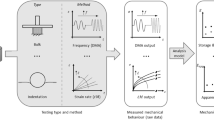Abstract
This work presents a new alternative to studying and determining the shear or torsion modulus, G. For this purpose, a measuring system was constructed with a rotational motion sensor coupled to a torsion pendulum that allowed the determination of the angular position as a function of time. Through an equation derived from studies of mechanical spectroscopy and the theory of relaxation of materials, G was calculated, and experiments were focused on validating it. The advantage of this technique, compared to other dynamical methods, is that it is not necessary to know the Poisson’s ratio of the sample.
Similar content being viewed by others
References
D. Banerjee and J. C. Williams, Perspectives on titanium science and technology, Acta Materialia, 61 (2013) 844–879.
M. Niinomi, M. Nakai and J. Hieda, Development of new metallic alloys for biomedical applications, Acta Biomaterialia, 8 (11) (2012) 3888–3903.
T. Hanawa, Research and development of metals for devices based on clinical needs, Science and Technology of Advanced Materials, 11 (6) (2012) 64102–64116.
M. Long and H. J. Rack, Titanium alloys in total joint replacement-a materials science perspective, Biomaterials, 19 (1998) 1621–1639.
M. Geetha, A. K. Singh, R. Asokamani and A. K. Gogia, Ti based biomaterials, the ultimate choice for orthopaedic implants–A review, Progress in Materials Science, 54 (2009) 397–425.
R. Truel, C. Elbaum and B. B. Chick, Ultrasonic methods in solid state physics, Academic Press: New York (1969) 136–138.
B. D. Ratner, A. S. Hoffman, F. J. Schoen and J. E. Lemons, An introduction to materials in medicine, Biomaterials Science, Academic Press: New York(2004).
A. S. Nowick and B. S. Berry, Anelastic relaxation in crystalline solids, Academic Press, New York(1972).
F. A. Tyler, A Laboratory Manual of Physics, 4th Ed., Edward Arnold: London(1974) 22–24.
J. Goldemberg, Fisica Geral e Experimental, 2nd Ed., Companhia Editora Nacional: São Paulo(1970) 481–483.
P. F. Hinrichsen, Bifilar suspension measurement of boat inertia parameters, Journal of Sailboat Technology, 1 (2014) 1–37.
D. Amrani, Computerized rotational system to study the moment of inertia of different objects, Eur. J. Phys., 27 (2006) 1063–1069.
T. Eadkhong, R. Rajsadorn, P. Jannual and S. Danworaphong, Rotational dynamics with tracker, Eur. J. Phys., 33 (2012) 615–622.
I. W. Griffiths, J. Watkins and D. Sharpe, Measuring the moment of inertia of the human body by a rotating platform method, Am. J. Phys., 73 (2005) 85–92.
C. A. F. Pintão, M. P. de Souza Filho, C. R. Grandini and R. Hessel, Medida do momento de inércia disco, Rev. Bras. Ens. Fis., 23 (2001) 48–52.
C. A. F. Pintão, M. P. de Souza Filho, C. R. Grandini and R. Hessel, Experimental study of the conventional equation to determine plate’s moment of inertia, Eur. J. Phys., 25 (2004) 409–417.
C. A. F. Pintão, Measurement of the rotational inertia of bodies by using mechanical spectroscopy, J. Mech. Sci. Tech. (Seoul. Print), 28 (10) (2014) 4011–4020.
S. P. Timoshenko and J. N. Goodier, Teoria da elasticidade, 3ª Ed., Rio de Janeiro: Guanabara Dois(1980).
I. H. Shames and F. A. Cozzareli, Elastic and inelastic Stress analysis, Prentice-Hall International, Englewood Cliffs, New Jersey(1992).
A. P. Boresi and K. P. Chong, Elasticity in engineering mechanics, 2ª Ed., John Wiley & Sons(1999).
H. E. Boyer and T. L. Gal, Metal Handbook, ASM, Ohio(1985).
S. P. Timoshenko and J. M. Gere, Mechanics of Materials, Van Nostrand Reinhold Co., New York(1972).
P. Majundar, S. B. Singh and M. Chakraborty, Elastic modulus of biomedical titanium alloys by nano-indentation and ultrasonic techniques–A comparative study, Mater. Sci. Eng., A 489 (2008) 419–425.
Author information
Authors and Affiliations
Corresponding author
Additional information
Recommended by Associate Editor Sang-Hee Yoon
Carlos Alberto Fonzar Pintão was born in Bilac, Brazil in 1954. He received B.Sc. degree in Physics and Mechanical Engineering from the São Paulo University (USP) and the Faculty of Industrial Engineering (FEI), Brazil in 1985 and 1979, respectively, the M.Sc. degree from the São Paulo University (USP), São Carlos, Brazil in 1989 and the Ph.D. degree from the São Paulo University (USP), São Carlos, Brazil in 1996. During the last 29 years he has lectured Physics for Engineering and Physics courses. Most of his research is focused on electron secondary emission in metals and polymers, mechanical properties of materials (elastic modulus and internal friction) and physics experiments in education.
Rights and permissions
About this article
Cite this article
Pintão, C.A.F., Correa, D.R.N. & Grandini, C.R. Torsion modulus using the technique of mechanical spectroscopy in biomaterials. J Mech Sci Technol 31, 2203–2211 (2017). https://doi.org/10.1007/s12206-017-0416-6
Received:
Revised:
Accepted:
Published:
Issue Date:
DOI: https://doi.org/10.1007/s12206-017-0416-6




